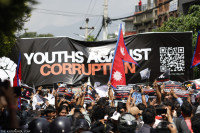Opinion
Waiting to be tapped
In Nepal, the narrative related to rivers is mostly dominated by hydropower. Hydroelectricity has always been considered as the Holy Grail that could not only light the lives of millions but be the source of their financial upliftment.
Dikshya Singh
In Nepal, the narrative related to rivers is mostly dominated by hydropower. Hydroelectricity has always been considered as the Holy Grail that could not only light the lives of millions but be the source of their financial upliftment. At times, irrigation creeps into the discourse because of the significance of agriculture for the economy and food security. However, water-related discourse has been ignoring one potential use of these rivers. This use pertains to navigation. Any mention of inland navigation or water transport revolves around recreational use for white water rafting. In addition, when it comes to transportation, national discourse is fixated on road expansion.
Perennial rivers such as Koshi, Gandaki, Karnali and Mahakali and their tributaries hardly have any water transport services. The boating services that are in existence are limited to river crossings on traditional wooden vessels to ferry passengers from one side of the river to another. There are some exceptions. For example, steamers operate on the Karnali River in Bardiya’s Rajapur area. Other exceptions include operation of a motorised boat on the Kali Gandaki River on a reservoir created by the construction of a dam for Kali Gandaki A Hydroelectric Project in Syangja. Similarly, on the Koshi River, from Chatara in Sunsari to Simle on the border of Bhojpur and Dhankuta, jet boats were in operation till spring 2012. Both these services were credited with easing the transport of people and commodities to and from difficult-to-reach places.
Tricky navigation
It is important to note that not all rivers can be navigable as they vary in characteristics depending on the free discharge of water and sediment. Navigating rivers in Nepal could be tricky as two thirds of the country’s land is covered by hills and mountains. The river hydrodynamics, and the associated sedimentation and erosion processes shape river behaviour. One of the basic preconditions for navigation is maintaining least available depth (LAD) of a minimum of five feet. Given that rivers in Nepal are monsoon-fed, maintaining required depth and draft would need river engineering, which would involve channelising the rivers and periodic dredging to remove silt and sediments from riverbeds. However, it does not mean that Nepal’s rivers are impossible to navigate.
Historically, areas in the Tarai flats used inland navigation to transport goods—usually as a means of freight carrier for goods coming in and out of India. Trivenidham in Nawalparasi district was one such thriving river port at the Nepal-India border. Boats were operated on the Narayani River to transport commodities brought from hills in Nepal to Trivenidham and shipped to India while the vessels carried other essential goods from India. But the construction of the Gandak Barrage in the 1960s made the river difficult to navigate. Further, construction of the East-West Highway in Nepal diverted the river traffic to the road. The presence of Chitwan National Park on the course of the Narayani River has further complicated the possibility of motorised water transportation due to conservation issues.
In the 1960s, the government conducted a survey regarding the feasibility of developing inland water transport in Nepal, which recommended Narayani as the ideal river to develop navigation. Reconnaissance studies were also conducted in the Koshi River in the 1970s and 1980s, but they failed to make any major breakthroughs in developing inland navigation. All of these studies pointed out a lack of all-year round draft and heavy silt content as the problems. In the latest study conducted in 2012, the Ministry of Physical Infrastructure and Transport had commissioned a feasibility study for water transport in the Koshi, Gandaki and Bheri River basins. The study concluded that 12 of the 14 routes they appraised were suitable for operating vessels for recreational and touristic purposes.
Worthwhile plans
Most of the studies conducted regarding inland waterways have not written off the possibility of river navigation in the rivers. If navigation is impossible in Nepal, then why do the Water Resource Strategy 2002, National Transport Policy 2002 and National Water Plan 2005 all include development of inland water transport as a worthwhile plan? If plans of navigation were advisable then why didn’t successive governments take steps towards realising these strategies? If navigation is to be abandoned as a worthwhile project, would it not be better to undertake a detailed hydro-morphological study to give a verdict on the navigability of Nepali rivers?
These questions have become relevant as India has embarked on an ambitious plan for developing its own waterways as a viable mode of transport. Among the eight waters identified by the Inland Waterways Authority of India (IWAI) for development in the first phase are Gandak (NW-37), Kosi (NW-58) and Ghaghra (NW-40), which are the Himalayan rivers known in Nepal as Saptagandaki or Narayani, Koshi and Karnali, respectively. India has already started construction of a multi-modal terminal at Haldia, which is one of the three gateways ports for the inbound and outbound cargo of Nepal and has floated plans to divert a portion of Nepal bound cargo to its riverports in Patna via its National Waterways 1, that is, the Ganges. It would be in Nepal’s interest to prepare to get the maximum benefits out of India’s waterways.
Besides the obvious benefits of connectivity for improved trade facilitation, developing domestic waterways can contribute to the livelihood of the local populace. The existing steamer service at Seti Beni in Syangja has made transportation of goods and passengers easier while establishing the area as a vital tourist location. In the Koshi River too, the boat service had animated the economy by facilitating transportation and tourism.
Nepal, which has more than 6,000 rivers with a cumulative length of 45,000km, has a potential to use its river systems to create an alternate mode of transportation and eventually be connected to international waters. Unfortunately, a lack of institutional and physical infrastructure regarding water transport has left inland navigation as an untapped sector. It needs to be acknowledged that by ignoring the possibility of creating an alternative mode of transport via rivers, Nepal may have forgone a lucrative sector that could have a significant impact on the rural livelihoods thriving on the banks of these rivers. Inland waterways transport is recognised globally for its superior record of safety, reliability, low costs, high-energy-efficiency, good carbon footprint, low infrastructure costs, among others. However, for water to become a thriving mode of transport, supportive legal and institutional infrastructure is also an imperative. In addition, private sector investment is also necessary. Else, water transport will remain a pipe dream.
- Singh is Research Officer at South Asia Watch on Trade, Economics and Environment (SAWTEE)




 14.12°C Kathmandu
14.12°C Kathmandu










